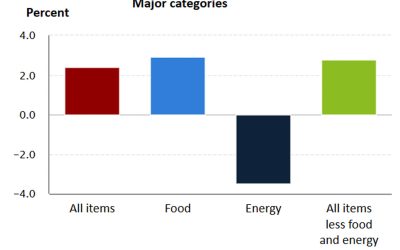Understanding gold’s performance under different market scenarios
Understanding gold’s performance under different market scenarios

The role of gold in investment portfolios: Part I
Should an investment in gold be a key element of effectively diversified and risk-managed portfolios?
Editor’s note: Flexible Plan Investments, a leading provider of dynamically risk-managed investment strategies, first authored an extensive analysis of the role of gold in investment portfolios in 2013 and has provided periodic updates. This white paper has been recently updated for 2024 and will be presented as a guest commentary in two parts in Proactive Advisor Magazine. We are pleased to present Part I here.
Gold’s enduring allure and utility as an asset class have sparked substantial discourse among investors and financial professionals. This white paper explores gold’s historical and quantitative significance in diversified investment portfolios. Our analysis spans from 1973 to 2023, a period notable for significant economic changes and monetary policy shifts following the U.S. departure from the gold standard. Using a robust quantitative approach, we ascertain the optimal gold allocation in a typical balanced portfolio (60% equities, 40% bonds). We find that allocating between 1% and 34% of the portfolio to gold, with an optimal mark of 17%, substantially improves the portfolio’s risk-adjusted returns. We also examine various market conditions, including negative real interest rates, equity bear markets, and high inflation periods, to evaluate gold’s performance relative to other major asset classes. Contrary to conventional wisdom, our results support a strategic inclusion of gold to enhance portfolio resilience against market volatility and economic uncertainty.
What role should gold play in modern portfolio diversification?
Even the staunchest supporters of traditional portfolio and investment management theories have had their belief systems shaken to the core this century. The “boom and bust” volatility and unprecedented global systemic risk have forced traditional advisers and individual investors to rethink their risk-management approaches and consider new alternatives for building portfolios. Asset classes have challenged historical norms.
This white paper examines the ongoing debate over gold’s role in investment portfolios. In particular, we seek to provide a quantitative analysis of gold in various economic and market regimes to demonstrate its value as an alternative source of return and hedge against risks associated with other asset classes.
Many traditional wealth and portfolio managers recognize gold’s importance in investor portfolios, but the rationale for its inclusion can often seem thin and instinctual. Therefore, this paper aims to present historical evidence and eye-opening data demonstrating the tangible benefits of diversifying portfolios with gold, particularly for portfolios seeking optimal risk-adjusted returns.
We begin with a brief history of gold and its use as a currency throughout the ages. We then look at the most enduring arguments for including gold in a portfolio, such as its potential to hedge against inflation, protect against declining currencies, and serve as a haven during geopolitical and financial market instability. We discuss seven periods of crisis that investors most fear and present 50 years of data supporting gold’s role in helping advisers and their clients navigate such challenging times. Finally, we explore gold’s utility in various economic regimes and determine its optimal allocation in a typical balanced investor portfolio (60% equity/40% bond).
A brief history of gold
Gold has been universally revered throughout history as the embodiment of enduring wealth and status. Examples like King Midas, famed in Greek mythology for his “Midas touch,” and El Dorado, the mythical “Lost City of Gold,” illustrate the powerful allure of gold. The quest for gold has created and toppled dynasties and nation-states over the millennia.
Gold has been used as a form of currency for thousands of years. Unlike paper or some electronic currencies, gold has a fixed supply and is challenging to obtain as a physical commodity. Historically, this has made gold a natural hedge against inflation and a reliable alternative for investors when other forms of currency depreciate.
But what does this mean for today’s investors and those entrusted to manage their portfolios?
The role of gold in
investment portfolios
This two-part guest commentary
by Flexible Plan Investments explores
why investors should reconsider
their portfolio’s allocation to gold.
Part II: How gold can help in creating a more optimal portfolio allocation
Some traditional arguments for gold
Before we delve into the quantitative analysis, let’s examine some of the most enduring arguments for including gold in a portfolio.
Investment professionals, economists, hedge fund managers, and prominent Wall Street strategists make compelling arguments for gold’s role in portfolio management.
Ray Dalio, founder of Bridgewater Associates LP (generally regarded as the world’s largest hedge fund), shared this in a 2019 post on LinkedIn:
“I believe that monetizations of debt and currency depreciations will eventually pick up, which will reduce the value of money and real returns for creditors and test how far creditors will let central banks go in providing negative real returns before moving into other assets. … Those that will most likely do best will be those that do well when the value of money is being depreciated and domestic and international conflicts are significant, such as gold.”
Academic literature, financial journalism, respected Wall Street firms, and the investing community consistently highlight several vital potential benefits of including gold in a portfolio. Gold offers:
- A hedge against inflation.
- Protection against a declining currency (e.g., the U.S. dollar).
- A haven in times of geopolitical and financial market instability.
- Value as an essential commodity with its own supply-and-demand fundamentals.
- A proven store of historical value.
- An “insurance policy” against catastrophic events and extreme market downturns.
- Low correlations to other asset classes.
- Value due to its underlying demand from global central banks and sovereign wealth funds.
- Potential for increased demand as a relatively under-owned investment class.
- Essential diversification for investment portfolios.
These arguments have supporters and naysayers armed with specific analyses and biases. However, even the most well-credentialed critics of gold grudgingly admit that it has a role in most investor portfolios.
In his paper “The Truth about Gold: Why It Should (or Should Not) Be Part of Your Asset Allocation Strategy,” Professor Campbell R. Harvey of Duke University’s Fuqua School of Business summarized, in part,
“The attractiveness of gold as an investment can generate heated arguments, many of which are based on wishful thinking rather than fact. … Most arguments for holding gold in a portfolio are not supported by an analysis of the data. Nonetheless, an argument can be made for including gold as a commodity in a well-diversified portfolio, particularly if investors and central banks increase their demand—even moderately—for gold.”
Oxford Economics’ 2011 independent, proprietary study “The Impact of Inflation and Deflation on the Case for Gold” concluded,
“We find that because of its lack of correlation with other financial assets, gold has a useful role to play in stabilizing the value of a portfolio even if the conservative assumption of a modest negative real annual return is made.”
Of course, there are no guarantees of even “a modest negative real return” on one’s investment in gold. Like all asset classes, gold can experience periods of extreme volatility. Gold’s volatility can be intimidating for short-term traders and should be considered principally as a long-term portfolio component for most investors. Of course, for professional traders, its volatility can also make gold an excellent tactical trading tool.
A quantitative analysis of gold’s role in investment portfolios
Opinions about including gold in investment portfolios are highly polarized, making it challenging to separate hyperbole from facts. It is necessary to fully understand the economic and market drivers that can make gold a valuable constituent of a typical investor’s portfolio.
Our quantitative assessment will focus on gold’s performance relative to other major asset classes under various market and economic conditions since 1973, following the U.S. abandonment of the gold standard.
For years, the U.S. priced gold at a fixed rate of $35 per ounce and exchanged U.S. dollars for gold only at that set rate. In 1971, the Nixon administration made the momentous decision to remove the U.S. from the gold standard.
Since then, investors have faced a multitude of challenges, including several energy crises, the interest-rate spikes of the 1970s and early 2020s, the COVID pandemic and subsequent lockdowns, and many significant macro geopolitical events—including the major stock market booms and busts of the 1990s and 2000s.
Now that we have defined our time period, let’s establish a baseline for our asset classes by examining their annualized rate of return from February 1973 through December 2023 (Figure 1).
FIGURE 1: BASELINE—PERFORMANCE OF VARIOUS ASSET CLASSES (1973–2023)
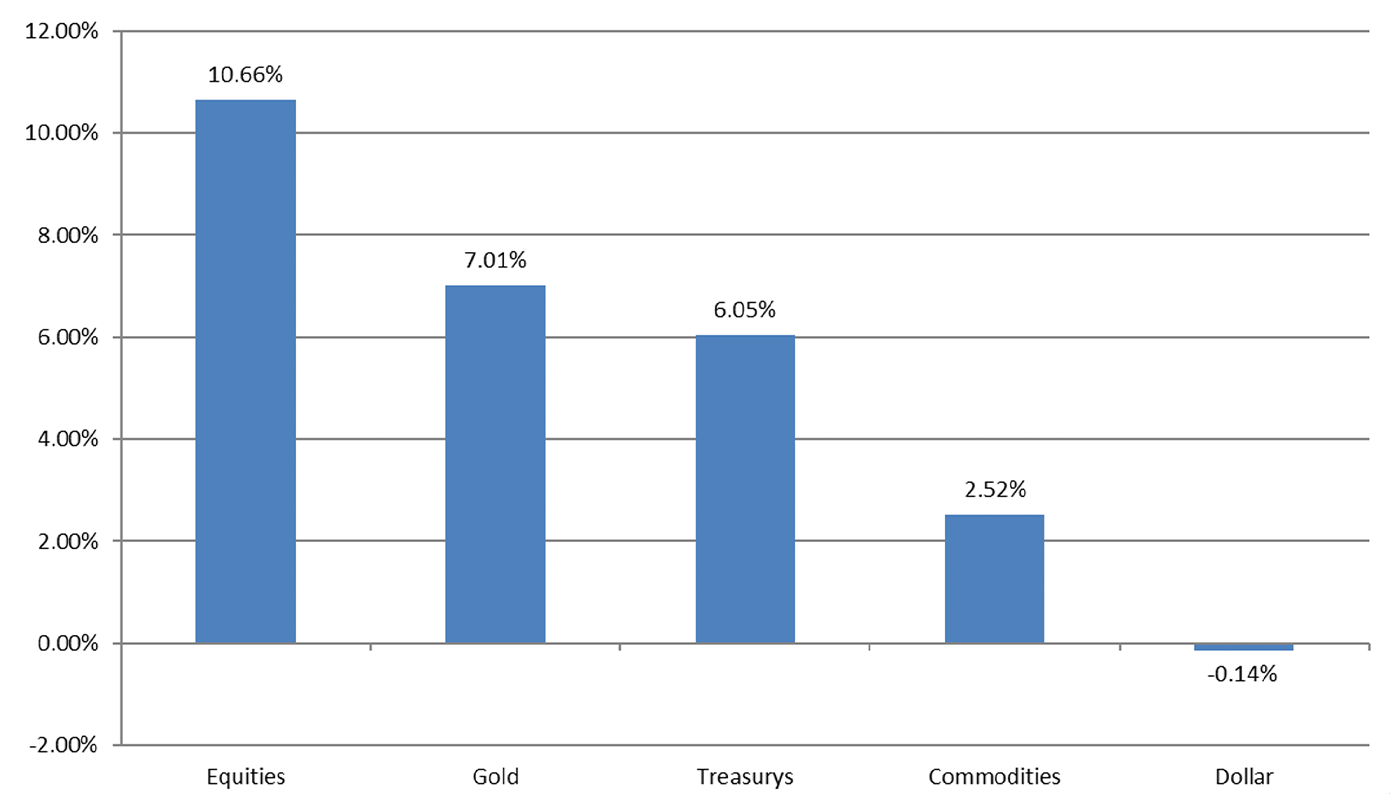
Definition: Annualized returns of various asset classes over time. See the note at the end of this article for more information on source data.
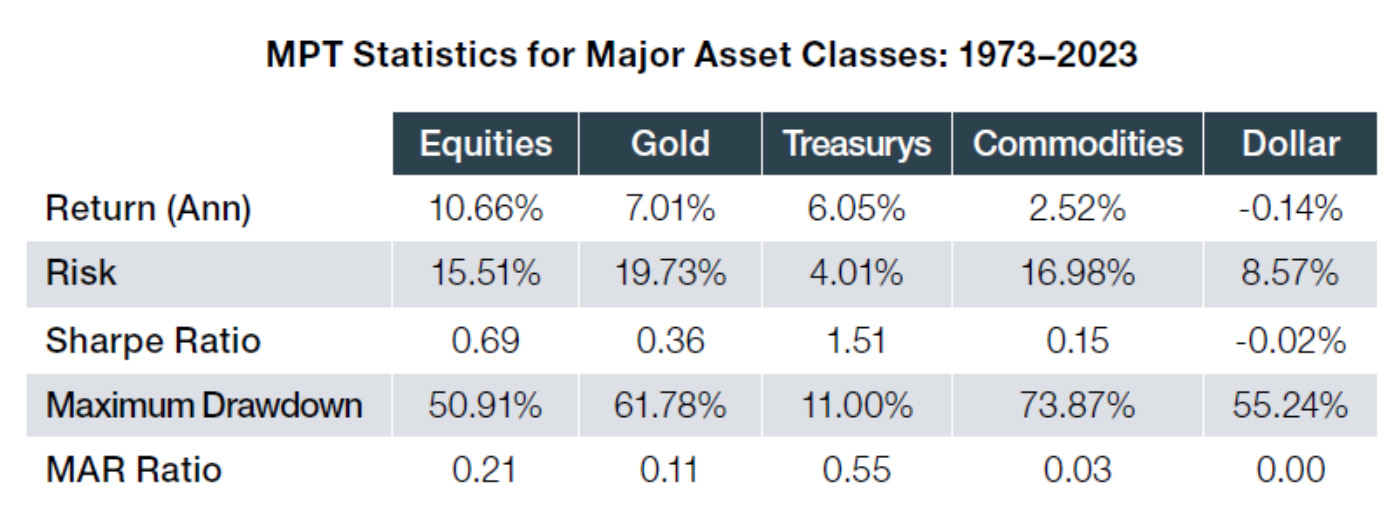
Source: Flexible Plan Investments
Equities have been the best-performing asset class throughout this period, followed by gold and Treasury bonds. However, equity performance has been far from a “smooth ride” for several decades. Although gold has experienced an even bumpier journey, it has shown it can outperform equities during equity market stress and surpass bonds during different economic conditions.
It is also noteworthy that the U.S. dollar fell during the period. In addition, commodities rose, suggesting that the period was typically inflationary. These conditions provided a tailwind for gold.
We will review several economic scenarios, again based on historical data from February 1973 through December 2023. We will examine the performance of gold relative to other asset classes under seven different market environments that typically concern investors:
- Real returns on the 10-year Treasury bond are negative (i.e., interest rates after subtracting the inflation rate are less than zero).
- Equities are in a bear market.
- Commodities are in a bull market.
- The U.S. dollar is in a bear market.
- Prices are rising.
- Inflation is high.
- Market volatility is high.
We first identified the dates when each specified condition was present to conduct these comparisons. Next, we calculated the monthly rate of total return achieved by each asset class during these periods. We then calculated a compounded annual return by geometrically linking each period of monthly returns for the various periods of the condition for each asset class. Finally, we compared the performance of all asset classes for the studied period.
Scenario #1: Real rates on Treasury bonds are negative
One of the most important benchmarks for investor returns is the “real” 10-year yield. For this study, we calculate the real yield by subtracting the inflation rate during the period from the yield on the 10-year Treasury bond. Since the Treasury return is considered virtually “risk-free,” this figure represents what an investor can reasonably expect to earn on a long-term investment, adjusted for changes in currency purchasing power.
Typically, when real yields are positive, equities and bonds perform well as long-term investments. However, the nightmare scenario that keeps pension-fund and other asset managers up at night is when real yields are negative.
Under certain conditions, investors are willing to accept a negative real return in exchange for “safety” and the likelihood that they will recover most of their invested principal.
Negative real rates have been standard since the 2007–2009 financial crisis, mainly because the Federal Reserve systematically lowered interest rates to near-zero levels to boost the economy. As a result, Treasury yields fell below the inflation rate for much of 2011, 2012, and from 2020 to 2023, indicating that real yields were negative.
In such an environment, the question becomes, “How can investors earn a real return on their investments?” As it turns out, gold has historically been the great savior in this scenario.
Figure 2 shows the compounded annual return for various asset classes when real 10-year yields are negative.
FIGURE 2: PERFORMANCE OF VARIOUS ASSET CLASSES WHEN REAL RATES ARE NEGATIVE (1973–2023)
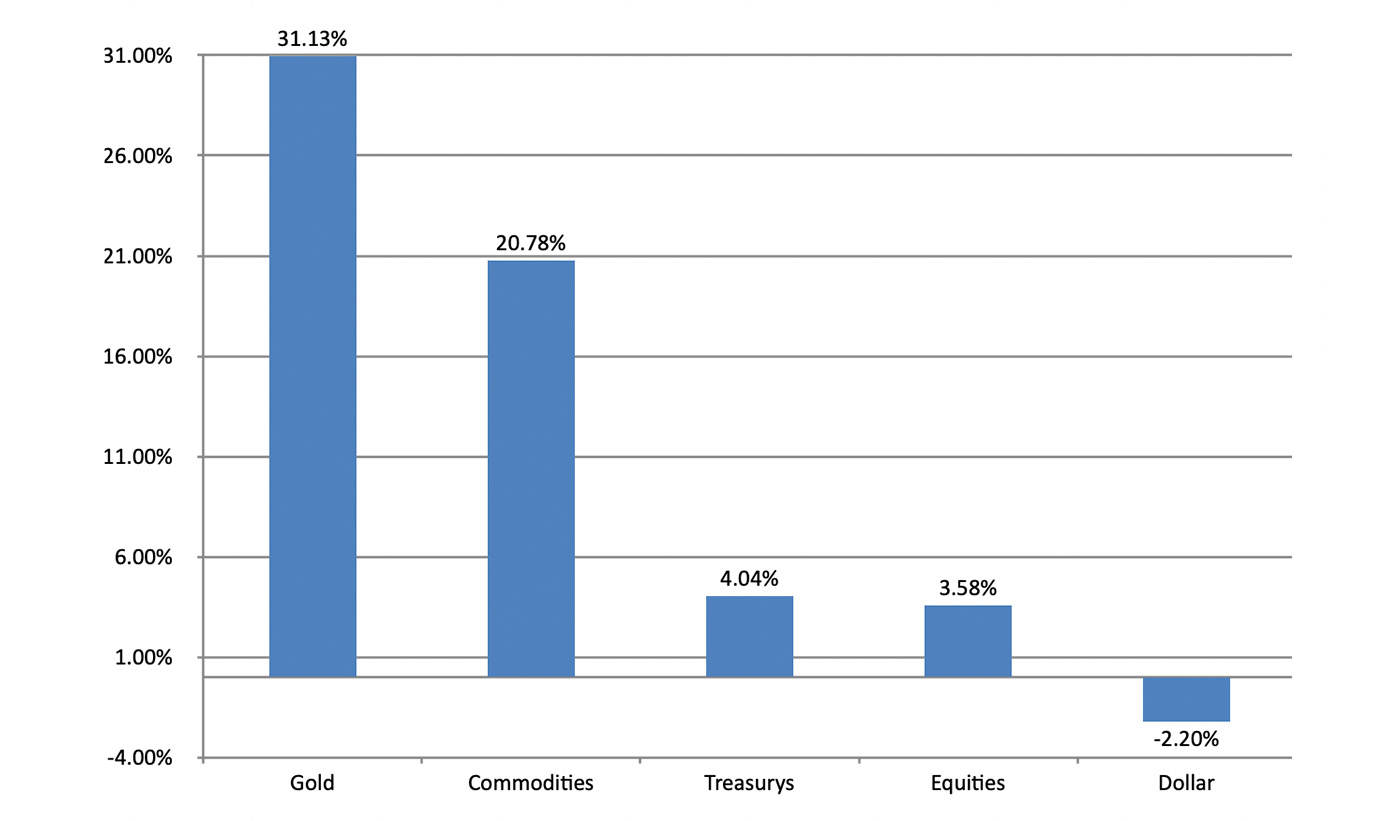
Definition: When the yield of a 10-year Treasury bond minus the inflation rate is negative.
Source: Flexible Plan Investments
Gold is the best-performing primary asset class, delivering annualized returns of over 31% when real Treasury rates are negative. The other asset classes, except for commodities, fare far worse in this environment.
Periods of negative real rates often overlap with high inflation. Both environments have favored gold as a safe haven asset for investors. While commodities as a whole have also done well in these environments, gold comes out on top.
Scenario #2: Equities are in a bear market
Gold also provides valuable protection during equity bear markets. While one might expect Treasurys to perform best in such conditions, that has not been the case.
To determine which asset class has performed best during equity bear markets, we categorized equity returns from our study period as bull and bear phases based on percentage increases/decreases. We then assessed the returns of the asset classes during the bear periods (Figure 3).
FIGURE 3: PERFORMANCE OF VARIOUS ASSET CLASSES IN EQUITY BEAR MARKETS (1973–2023)
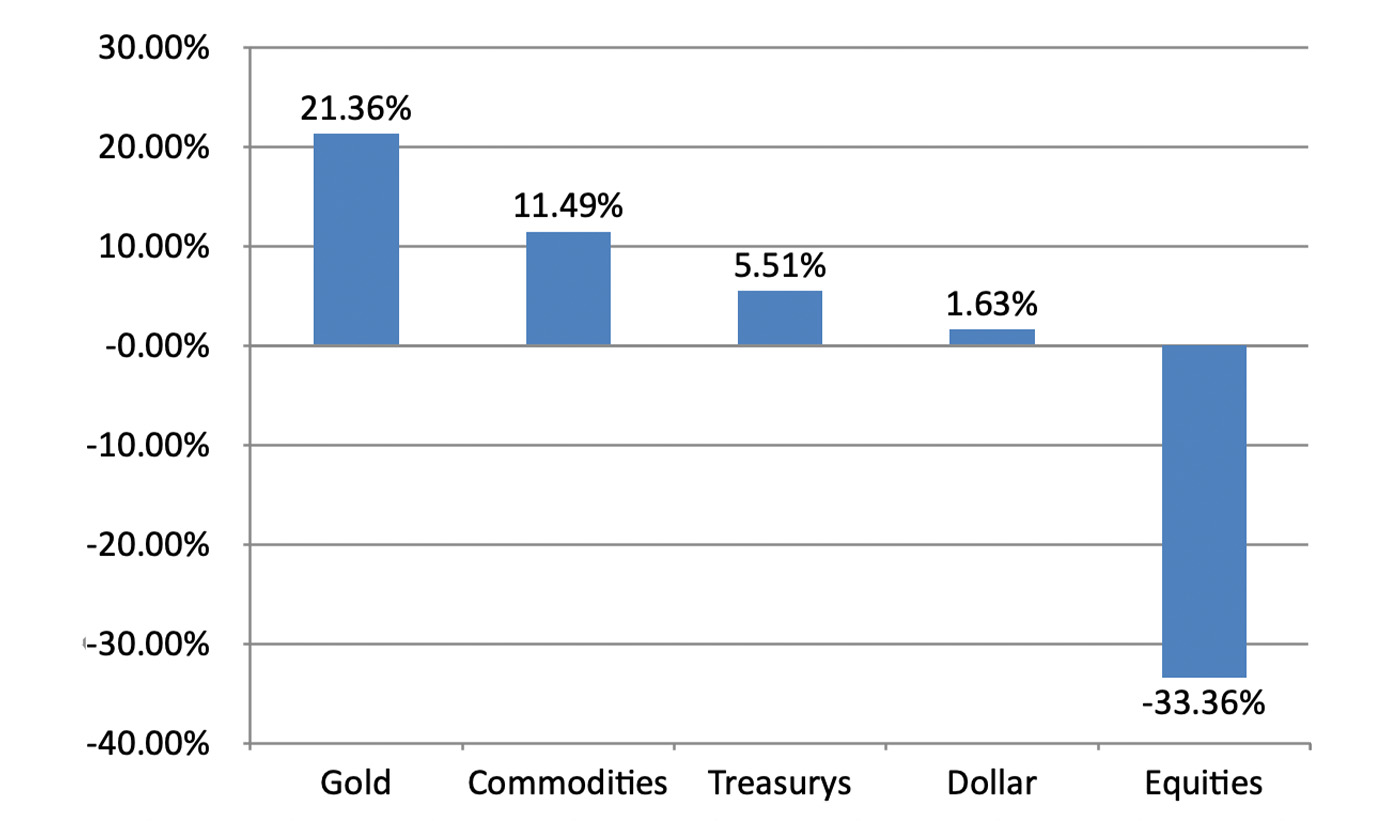
Definition: Equity bear markets occur when equity prices decrease by 20% or more.
Source: Flexible Plan Investments
Gold has outperformed all other asset classes during periods of equity market stress, achieving higher historical compounded returns than Treasurys. Investors often seek safety in gold during turbulent economic times. In addition, because gold has limited demand as an industrial metal, it tends to show little economic sensitivity.
During the major equity bear market and global financial crisis from November 2007 through February 2009, the equity market fell by 50.91%. In contrast, gold rose 20.58%, more than Treasurys and the U.S. dollar, which gained 12.42% and 15.07%, respectively. Commodities declined 42.25%, clearly failing to provide the safety net that gold did.
Scenario #3: Commodities are in a bull market
Figure 4 shows the performance of the different asset classes during commodity bull markets. While gold provided better returns than commodities in equity bear markets, it was also the second-best performer in commodity bull markets. Thus, gold has effectively served as a safeguard in equity bear markets and a valuable substitute for broader commodity exposure.
FIGURE 4: PERFORMANCE OF VARIOUS ASSET CLASSES IN COMMODITY BULL MARKETS (1973–2023)
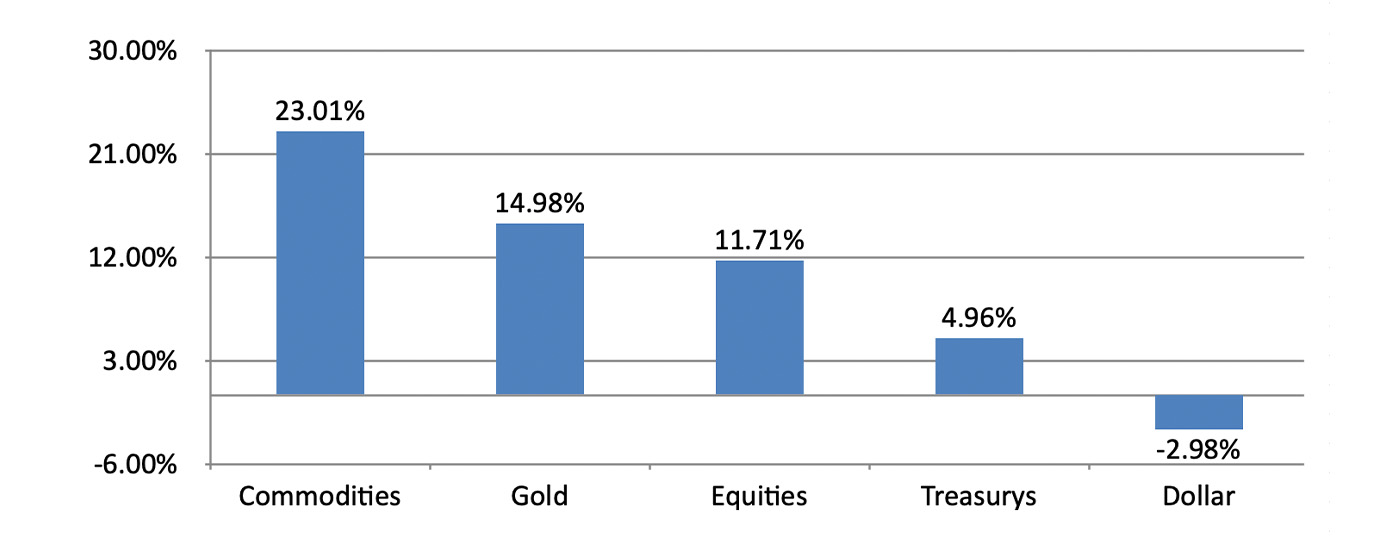
Definition: Commodity bull markets occur when commodity prices rise 20% or more.
Source: Flexible Plan Investments
One significant commodities bull market occurred from March 1975 to October 1980, coinciding with U.S. President Jimmy Carter’s famous warning that the world was running out of oil, heightened tensions with Iran, and a phased deregulation of oil prices. Commodities rose 152.57% over that period, while gold soared 246.08%.
Scenario #4: The U.S. dollar is in a bear market
We also examined historical periods when the value of the U.S. dollar decreased relative to a “basket” of foreign currencies (Figure 5).
FIGURE 5: PERFORMANCE OF VARIOUS ASSET CLASSES IN U.S. DOLLAR BEAR MARKETS (1973–2023)
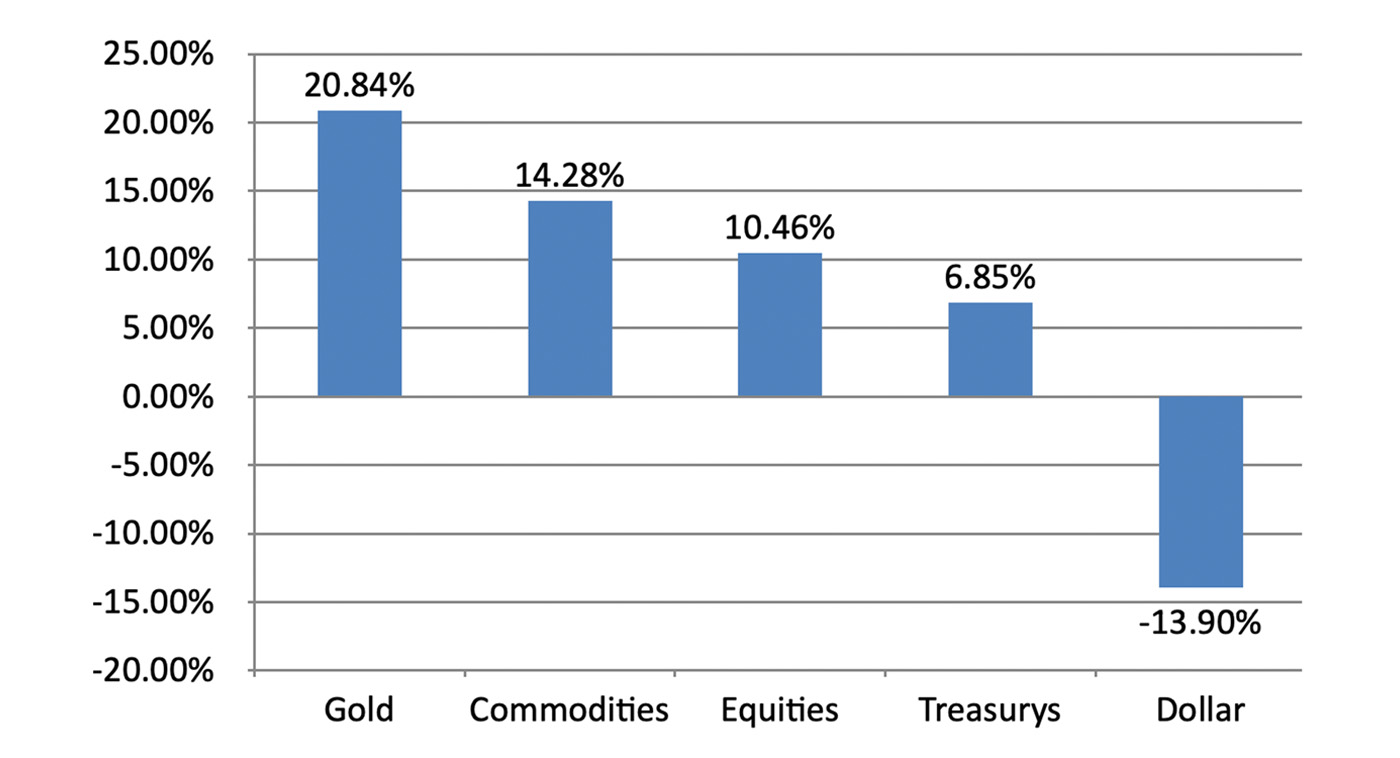
Definition: Bear markets for the U.S. dollar are said to occur when prices decrease 10% or more.
Source: Flexible Plan Investments
A U.S. dollar bear market can occur for several reasons, including trade and budget deficits or monetary policy decisions. The data in Figure 5 shows that gold performed exceptionally well, outperforming all other asset classes during periods of a declining U.S. dollar. This outperformance may be attributed to gold being widely regarded by investors as the currency of last resort.
For example, the Bretton Woods agreement resulted in a fixed-exchange-rate system where investors could exchange U.S. dollars for gold at a fixed price of $35 per ounce, and other major world currencies had a fixed exchange rate to the dollar. In 1971, facing a growing deficit in U.S. gold reserves compared to outstanding U.S. dollars, President Nixon suspended the convertibility of dollars to gold. Consequently, the U.S. dollar entered a bear market from February 1973 to July 1973, declining roughly 15%. Gold rose around 75% over the same period.
Scenario #5: Prices are rising
Figure 6 shows gold’s historically positive performance during periods of rising prices for goods and services, as indicated by the consumer price index (CPI).
In this environment, the U.S. dollar weakened in both “price” and purchasing power. Gold outperformed a basket of commodities, indicating that its value held up better than other goods while prices rose. However, equities have historically outperformed gold during these periods, while Treasurys have performed slightly worse.
FIGURE 6: PERFORMANCE OF VARIOUS ASSET CLASSES WHEN PRICES ARE RISING (1973–2023)
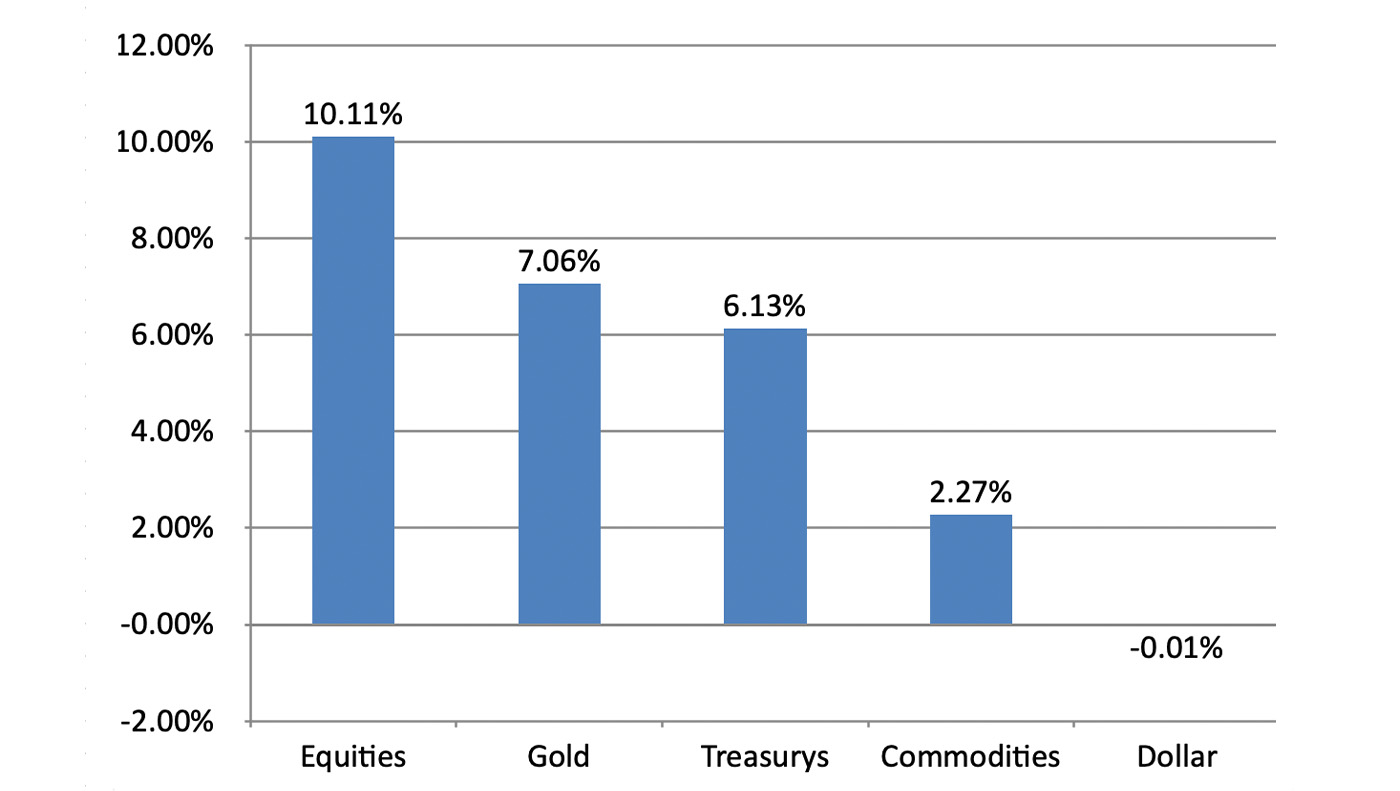
Definition: Periods when the CPI is rising.
Source: Flexible Plan Investments
Scenario #6: Inflation is high
Figure 7 shows the performance of different asset classes when inflation is high, as opposed to just rising. We define high inflation as periods when inflation exceeds its average of 4.01% over the study period.
During these periods, gold performed the best, followed by Treasurys. This diverges from what we saw in Scenario #5, the rising-price environment, where equities performed the best.
FIGURE 7: PERFORMANCE OF VARIOUS ASSET CLASSES WHEN INFLATION IS HIGH (1973–2023)
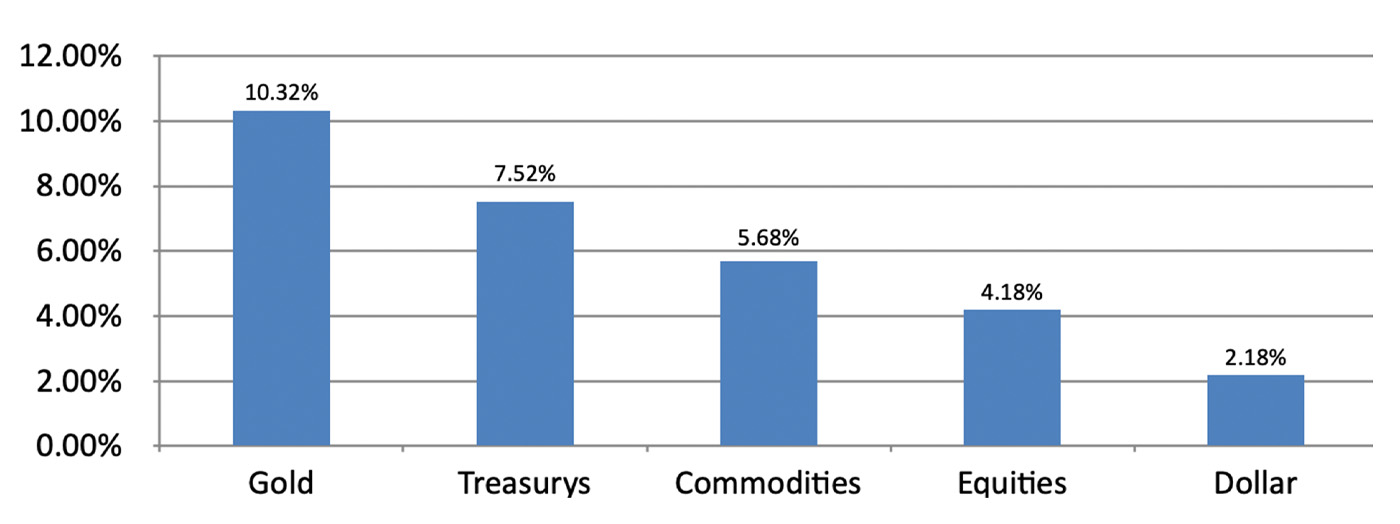
Definition: The annualized rate of inflation is higher than 4.01%.
Source: Flexible Plan Investments
From April 2021 to May 2023, we saw the first sustained period of high inflation in a long time. During that time frame, commodities returned 17.4%, gold rose 16.16%, the dollar increased by 11.90%, equities gained 8.80%, and Treasurys fell 5.85%. Once again, gold provided value to those holding it during high inflation, yielding higher returns than all other asset classes except commodities.
Scenario #7: Market volatility is high
We define high market volatility as periods when the implied volatility index (VIX) levels were in the top quintile of their 34-year history. Gold has been the best-performing asset class in these environments, followed by Treasurys (Figure 8). The strong performance of Treasurys and gold during these periods highlights their typical role as “crisis hedges” in investment portfolios, as investors seek safety.
FIGURE 8: PERFORMANCE OF VARIOUS ASSET CLASSES WHEN VOLATILITY IS HIGH (1990–2023)
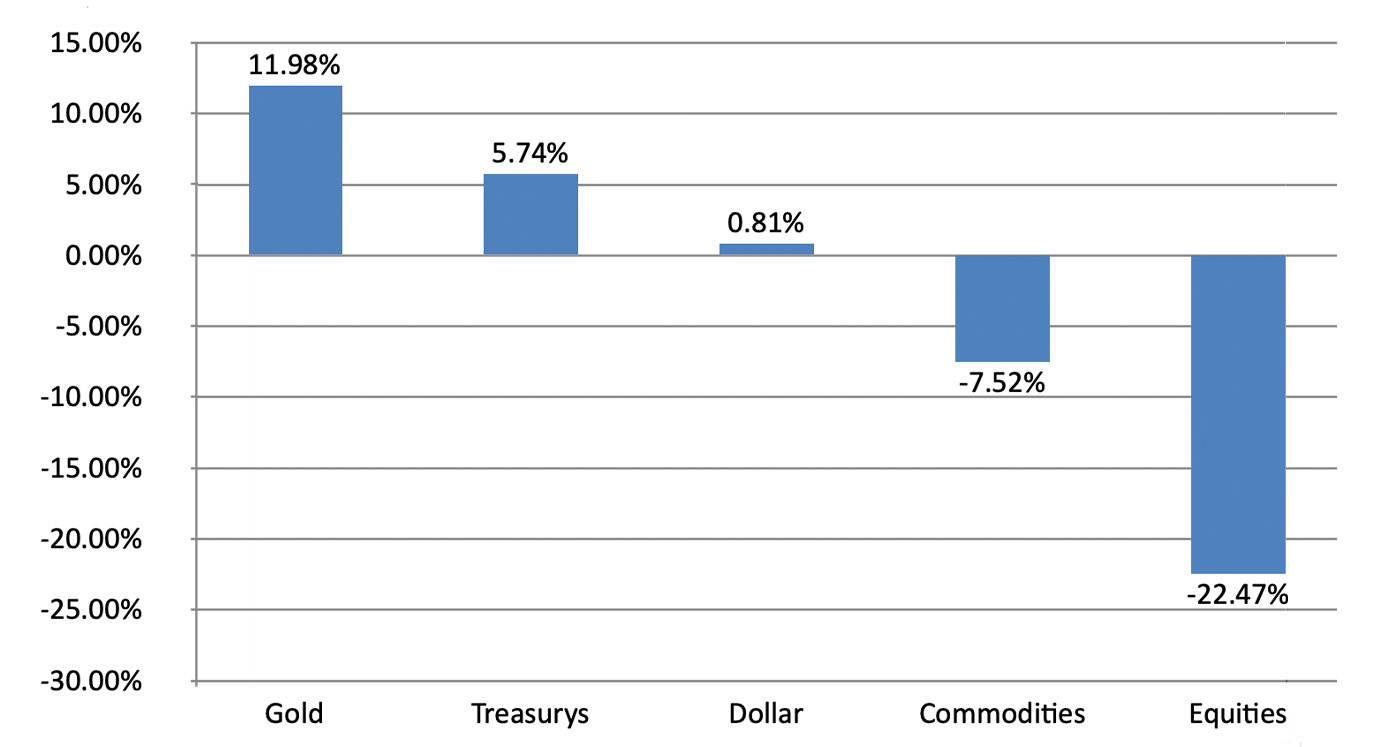
Definition: The VIX is in the top quintile of historical data.
Source: Flexible Plan Investments
For example, a sustained period of high market volatility occurred between February and June 2020 amid the global impact of the COVID-19 pandemic. During this time, the returns of the asset classes were 11.61% for gold, 4.33% for Treasurys, 0.00% for the dollar, -3.04% for equities, and -13.18% for commodities. Gold and Treasurys served as safe havens during the heightened market volatility and uncertainty, with gold emerging as the top performer.
Editor’s note: It is clear from the examples given here that gold can provide favorable returns and act as an important counterbalancing portfolio component under a variety of very specific market and economic conditions.
But, how does gold perform under different classic economic regimes?
Part II of “The Role of Gold in Investment Portfolios” will examine this question in some detail, as well as provide overall conclusions surrounding optimal allocations to gold in a modern portfolio. Look for Part II in an upcoming issue of Proactive Advisor Magazine.
The opinions expressed in this article are those of the author and the sources cited and do not necessarily represent the views of Proactive Advisor Magazine. This material is presented for educational purposes only.
This article presents an excerpt from the white paper “The Role of Gold in Investment Portfolios.” The complete paper—including a list of source data—can be found here.
This white paper is provided for information purposes only. It should not be used or construed as an indicator of future performance, an offer to sell, a solicitation of an offer to buy, or a recommendation for any security. Flexible Plan Investments, Ltd., cannot guarantee any particular investment’s suitability or potential value. Information and data set forth herein have been obtained from sources believed to be reliable, but that cannot be guaranteed. Before investing, please read and understand Flexible Plan Investments, Ltd., ADV Part 2A and Part 3 (Form CRS) 1. Past performance does not guarantee future results. Inherent in any investment is the potential for loss as well as profit. A list of all recommendations made within the immediately preceding 12 months is available upon written request.
The original white paper, published by Flexible Plan Investments in November 2013, was written by David Varadi, David Wismer, and Jerry C. Wagner. The updated white paper, published in May 2024, was revised by Jerry C. Wagner and Daniel Poppe. flexibleplan.com
Since 1981, Flexible Plan Investments (FPI) has been dedicated to preserving and growing wealth through dynamic risk management. FPI is a turnkey asset management program (TAMP), which means advisors can access and combine FPI’s many risk-managed strategies within a single account. FPI’s fee-based separately managed accounts can provide diversified portfolios of actively managed strategies within equity, debt, and alternative asset classes on an array of different platforms. FPI also offers advisors the OnTarget Investing tool to help set realistic, custom benchmarks for clients and regularly measure progress. flexibleplan.com
RECENT POSTS





